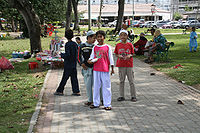- Thai Malays
-
For other uses, see Malay.
Thai Malays
ไทยเชื้อสายมลายู
Orang Melayu ThaiEthnic Malay boys in Songkhla. Total population 1.9 million (2006 estimate)[1] Regions with significant populations  Thailand
ThailandLanguages Pattani Malay, Thai, Kedahan Malay
Religion Related ethnic groups Kelantanese Malay, Kedahan Malay, Burmese Malays, Malays
Thai Malays (Malay: Melayu Thai, Thai: ไทยเชื้อสายมลายู) is a term used to refer to ethnic Malays in Thailand. Thailand hosts the third largest ethnic Malay population after Malaysia and Indonesia, and most Malays are concentrated in the Southern provinces of Narathiwat, Pattani, Yala, Songkhla and Satun.
Ethnic Malays in Narathiwat, Pattani, Yala and Songkhla due in part to cultural differences from the Thai people as well as past experiences of forced attempts to assimilate them into Thai mainstream culture after the eventual annexation of Pattani Kingdom by the Sukhothai Kingdom.[2] On the other hand, ethnic Malays in Satun are less inclined towards separatism.[3] Ethnic Malays in Satun are more proficient in Thai as compared to the Malays from the other states, and their dialect have strong affinities to those of Perlis.[4]
People of mixed Thai and Malay ancestry are known as Samsam,[5] which forms the bulk of Satun's population but also a significant minority in Phatthalung,[6][7][8] Trang, Krabi, Phang Nga and Songkhla as well as in the Malaysian states of Kedah, Perak and Perlis. Samsams are generally adherents of Islam but culturally Thai, although Malay influences are co-dominant.[9] Phuket[10][11] and Ranong,[12] home to a sizeable Muslim population, also has many people who are of Malay descent.[13] A sizeable community also exists in Bangkok itself, having descended from migrants or prisoners who were relocated from the South from the 13th century onwards.[14]
See also
References
- ^ http://lcweb2.loc.gov/cgi-bin/query/r?frd/cstdy:@field(DOCID+th0052)
- ^ William M. Carpenter, James R. Lilley, David G. Wiencek, Henry Stephen Albinski. Asian Security Handbook: An Assessment of Political-Security Issues in the Asia-Pacific Region. M.E. Sharpe. pp. 240–6. ISBN 1563248131.
- ^ Moshe Yegar. Between Integration and Secession: The Muslim Communities of the Southern Philippines, Southern Thailand and Western Burma/Myanmar. Lexington Books. pp. 79–80. ISBN 0739103563.
- ^ Thomas M. Fraser. Rusembilan: A Malay Fishing Village in Southern Thailand. Cornell University Press. pp. 88.
- ^ Krasūand Sētthakān (1930). Siam: Nature and Industry. Bangkok Times Press, Ltd. pp. 100.
- ^ Royal Asiatic Society of Great Britain and Ireland (1834). Journal of the Royal Asiatic Society of Great Britain & Ireland. Cambridge University Press for the Royal Asiatic Society. pp. 167.
- ^ Institute of South East Asian Studies (1976). The South East Asian Review. The Institute of South East Asian Studies. pp. 15.
- ^ Nelson Annandale, Herbert C. Robinson (1903). Fasciculi Malayenses: Anthropological and Zoological Results. Longmans, Green & Co.. pp. 30.
- ^ Andrew Turton. Civility and Savagery: Social Identity in Tai States. Routledge. pp. 162–175. ISBN 0700711732.
- ^ phuket1.xls
- ^ Descendants of the White-Blooded Lady
- ^ ranong1.xls
- ^ Institute of South East Asian Studies. The South East Asian Review, 1976. The Institute of South East Asian Studies. pp. 167.
- ^ Mohamed Taher. Encyclopaedic Survey of Islamic Culture. Anmol Publications. pp. 228–9. ISBN 8126104031.
Ethnic groups in Thailand by language family Tai
Isan · Khorat Thai · Khün · Lanna · Lao · Lao Ga · Lao Krang · Lao Lom · Lao Loum · Lao Ngaew · Lao Song · Lao Ti · Lao Wieng · Lu · Northeastern Thai · Northern Thai · Nyaw · Nyong · Phu Thai · Phuan · Saek · Shan · Southern Thai · Tai Bueng · Tai Daeng (Red Tai) · Tai Dam (Black Tai) · Tai Gapong · Kaleun · Tai Nüa · Tai Wang · Tai Yuan · Thai (Central Thai) · YoyMalayo-Polynesian
Cham · Filipin · Male · Moken · Moklen · Pattani · Satun · Urak LawoiTibeto-Burman
Akha · Bamar · Bisu · Karen · Kayah · Lahu · Lisu · Lolo (Yi) · Mpi · Pa'o · Phrae Pwo · Phunoi · Pwo · S'gaw · UgongChinese
Chinese (general) · Han Chinese (Cantonese · Hakka · Hokkien · Teochew)Hmong-Mien
Hmong · Yao/Iu MienOther
Farang · Indians · Iranians · Japanese · Nepalis · PakistanisOverseas Malays  Australia
Australia  Burma
Burma  Egypt
Egypt  Sri Lanka
Sri Lanka  South Africa
South Africa  Thailand
Thailand 
This article about ethnicity or ethnology is a stub. You can help Wikipedia by expanding it.

